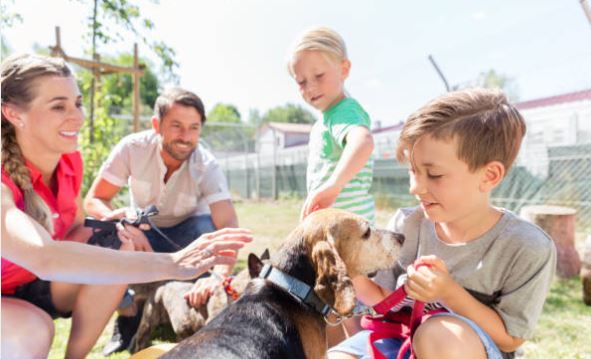
How to Adopt a Dog from a Shelter: Step-by-Step Guide
How to Adopt a Dog from a Shelter: A Step-by-Step Guide for New Pet Owners
Adopting a dog from a shelter is a rewarding experience that gives a deserving pet a second chance at a happy life. However, the process can be overwhelming for first-time adopters. From finding the right shelter to bringing your new dog home, each step requires thoughtful consideration and preparation. This guide will walk you through the adoption process, providing helpful tips and resources along the way. By the end, you’ll be well-equipped to welcome a shelter dog into your home with confidence.
1. Research and Choose a Shelter
Not all shelters operate the same way, so it's essential to find one that matches your needs and values.
- Search for Reputable Shelters: Look for local animal shelters or rescues with good reviews, proper certification, and transparent operations.
- Ask Questions: Call ahead to inquire about their adoption process, fees, and available support services.
- Consider Shelter Type: Some shelters specialize in certain breeds or have specific requirements. Knowing their policies ahead of time can streamline the process.
2. Consider Your Lifestyle and Needs
Before adopting, think about your lifestyle and what kind of dog would best fit it.
Essentials for Your Newly Adopted Pet
Welcoming a shelter pet into your life is a beautiful journey. Here are some handpicked items to help your new friend feel safe, loved, and right at home:
- Assess Your Living Situation: Certain dogs do better in large homes with yards, while others adapt well to apartments. Determine your space needs before selecting a dog.
- Consider Your Activity Level: If you're active, look for a high-energy dog. For a quieter lifestyle, consider a more relaxed breed or an older dog.
- Evaluate Time and Budget: Dogs require time, attention, and financial commitment. Make sure you can meet their needs in terms of daily care, vet visits, and other expenses.
3. Meet Different Dogs at the Shelter
Visiting the shelter and meeting different dogs can help you find the right match.
- Observe Behavior: Watch how each dog interacts with shelter staff and other animals. This can reveal their temperament and social preferences.
- Ask About Each Dog's History: Find out as much as possible about a dog's background, including any past trauma, health issues, or special needs.
- Schedule Multiple Visits: Don’t feel pressured to make a decision immediately. Visiting the dog several times can help you make a more informed choice.
Where Can I Adopt a Dog?
If you are ready to adopt, there are many wonderful shelters and rescue organizations across the shelters nationwide.. Here are a few trusted places to start:
-
You can also check your city’s local animal shelter or humane society for available dogs near you.

4. Speak to Shelter Staff and Volunteers
Shelter staff and volunteers know each dog’s personality and needs, and their insights can be invaluable.
- Ask for Temperament Insights: They can tell you how the dog behaves around other dogs, children, and strangers.
- Discuss Health History: Get a clear picture of any medical treatments, vaccinations, or special care the dog may need.
- Seek Training Information: Some shelter dogs have received basic training; knowing this can give you a head start on their behavior management.
5. Understand the Adoption Requirements
Many shelters have specific requirements to ensure that each pet finds a stable, loving home.
- Prepare Necessary Documentation: Some shelters may require proof of residency, references, or a completed application form.
- Learn About Fees and Costs: Shelters often charge adoption fees to cover vaccinations, spaying/neutering, and other initial care. Confirm the exact amount and what it covers.
- Understand Home Visit Requirements: Certain shelters may conduct a home visit to assess your environment. Be prepared to accommodate this request if necessary.
6. Prepare Your Home for the New Dog
Bringing a shelter dog home means creating a welcoming, safe space.
- Set Up a Dog-Friendly Area: Prepare a cozy space with a bed, food and water bowls, toys, and other essentials.
- Remove Potential Hazards: Ensure all hazardous items like chemicals, sharp objects, and small items are out of reach.
- Buy Basic Supplies: Have a leash, collar, food, treats, and grooming tools ready for your dog’s arrival.
7. Complete the Adoption Process
Once you've selected your dog, you'll need to finalize the adoption paperwork.
- Review the Contract Carefully: Understand all the terms, including any agreements regarding the dog’s future care.
- Pay the Adoption Fee: Make sure you know what the fee covers, such as vaccinations, microchipping, or a health guarantee.
- Collect Any Necessary Paperwork: Ensure you have copies of vaccination records, medical history, and any other relevant documentation for your new pet.
8. Plan the Trip Home
Transporting a shelter dog can be stressful for them, so plan a calm, comfortable trip home.
- Use a Safe Carrier or Leash: For small dogs, a carrier can be more comforting; larger dogs should be securely leashed and restrained.
- Bring Comfort Items: A blanket or toy can provide familiarity and reduce stress during the trip.
- Avoid Overstimulation: Keep the environment quiet and calm, especially if the dog is already anxious or nervous.
9. Allow Time for Adjustment
Adjusting to a new home can be challenging for a shelter dog. Patience is key.
- Establish a Routine: Dogs thrive on routine, which helps them feel secure. Set regular meal times, walking schedules, and bedtime routines.
- Give Them Space: Let them explore their new environment without pressure. Provide a designated safe spot where they can retreat.
- Observe Behavior and Set Boundaries: As they become comfortable, introduce boundaries for behaviors like chewing, barking, or jumping.
10. Schedule a Vet Check-Up
A visit to the vet ensures your new dog is in good health and helps you establish a healthcare plan.
- Review Medical Records: Share any records from the shelter with the vet to avoid redundant vaccinations and procedures.
- Get a Health Assessment: The vet can check for any hidden health concerns and provide preventive care like flea/tick prevention.
- Discuss Long-Term Care: Ask about nutrition, grooming, and any special care based on your dog’s breed, age, and health.
11. Begin Training and Socialization
Starting basic training helps your dog adapt to their new environment and builds a bond between you.
- Begin with Basic Commands: Start with essential commands like “sit,” “stay,” and “come.” Positive reinforcement with treats and praise works best.
- Socialize Gradually: If your dog is comfortable, slowly introduce them to other pets or people to build confidence and reduce fear.
- Use Gentle, Consistent Techniques: Shelter dogs may have trauma or anxiety, so avoid harsh training methods.
12. Join a Support Network or Training Group
Connecting with other dog owners or trainers can provide support and resources as you navigate dog ownership.
- Join Online Forums or Groups: Many online communities are dedicated to new pet owners and shelter dog adopters, providing advice and moral support.
- Consider Group Training Classes: Local obedience classes are a great way for you and your dog to learn together in a structured environment.
- Find Local Dog Meet-Ups: Dog meet-ups help socialize your pet and give you a network of like-minded individuals for advice.

In Summary- Adopting a dog from a shelter is a wonderful, life-changing experience that brings joy and companionship to both you and your new pet. By following this step-by-step guide, you’ll be well-prepared to welcome a shelter dog into your home, understand their needs, and build a loving relationship. With patience, consistency, and empathy, you can help your adopted dog thrive and make a positive impact in their life, providing them with the forever home they deserve.
Affiliate Products
We may earn a small commission when you shop through our links — it helps us keep sharing love and care for every dog out there, at no extra cost to you.
Up to 75% Discount

Dog Collar with Health Monitoring
BUY NOW »
Up to 55% Discount

Luxury Faux Furhuge Napping Bed
BUY NOW »

